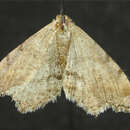en
names in breadcrumbs


Macaria minorata, the minor angle moth, is a moth of the family Geometridae. The species was first described by Alpheus Spring Packard in 1873. It is found in North America, where it has been recorded from Nova Scotia to Ontario, Quebec, Minnesota, New England, Maryland, North Carolina, South Carolina and Georgia.[1][2]
The wingspan is about 21 mm. Adults have been recorded on wing from March to October, with most records between May and August in one to two generations per year.
The larvae feed on Pinus strobus. Full-grown larvae can be found from July to October. They reach a length of 20 mm and have a green body, as well as a green head. The species overwinters in the pupal stage in the soil or amongst debris.[3]
Macaria minorata, the minor angle moth, is a moth of the family Geometridae. The species was first described by Alpheus Spring Packard in 1873. It is found in North America, where it has been recorded from Nova Scotia to Ontario, Quebec, Minnesota, New England, Maryland, North Carolina, South Carolina and Georgia.
The wingspan is about 21 mm. Adults have been recorded on wing from March to October, with most records between May and August in one to two generations per year.
The larvae feed on Pinus strobus. Full-grown larvae can be found from July to October. They reach a length of 20 mm and have a green body, as well as a green head. The species overwinters in the pupal stage in the soil or amongst debris.